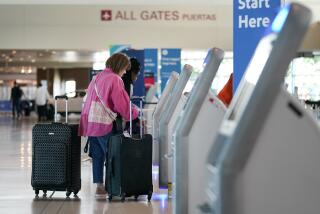Airlines Ask FAA to Require Infant Seats
- Share via
In an unexpected reversal, the U.S. airline industry Thursday petitioned the Federal Aviation Administration to require the use of infant safety seats on commercial flights for all passengers under 2 years of age.
The industry action came as separate bills were introduced in the House and Senate mandating the use of approved child safety seats on all U.S. commercial aircraft, a policy resisted by the FAA because of the potential cost to travelers.
If infant seats are required, parents could be forced to purchase tickets for an estimated 5,000 to 10,000 infants who fly every day at no cost under current airline policies, which allow adults to hold infant children in their laps if no empty seats are available.
Under existing regulations, airlines have the option of barring infant seats. The FAA has been considering a rule that would require airlines to accept the seats if passengers want to use them, but it would not mandate their use for all infants.
Concern over the safety of children on commercial airline flights increased after the recent crash of Avianca Airlines Flight 52 in New York. Of 17 passengers under the age of 2, one was killed and six others suffered injuries in the crash.
Last year, a 23-month-old boy died in the crash of United Airlines Flight 232 in Sioux City, Iowa. In that instance, the child’s mother lost control of the infant as the plane flipped over while attempting to land.
The industry’s new position was announced by the Air Transport Assn. of America, which called on the FAA to require the use of infant seats by all domestic airlines rather than allowing each carrier to determine its own policy.
ATA President Robert Aaronson said that recent tests conducted by the FAA’s Civil Aeromedical Institute had produced conclusive results that infants restrained in child safety seats are far safer than those held by a parent.
“If you buckle your children up at 50 miles per hour, why not at 550 miles per hour?” Aaronson asked. “No amount of strength in a parents arm’s can protect a child in a crash of only 10 to 12 miles an hour.”
ATA officials said the most recent figures available on survivable accidents indicate that only three deaths from 1976 to 1981 were caused by parents losing control of their children during a crash.
Even so, Aaronson noted that infants are at greater risk of sustaining injuries during turbulence, rough takeoffs and landings while in the lap of a parent.
ATA officials said that most infant seats currently designed for use in automobiles meet federal acceptance standards for air travel and carry a statement saying they are approved by the FAA for use on planes.
Aaronson acknowledged that before the Avianca and United crashes, some airlines would not allow the use of infant seats.
But he said a consensus is developing among airlines, medical organizations, consumer groups and others that their use should be mandated. Support for an infant seat requirement also has been voiced by flight attendants.
If child seats are required, Aaronson said, airlines probably would continue to allow infants to fly free when extra seats are available, but parents could be forced to pay full or discount fares on fully booked flights.
Sen. Christopher S. Bond (R-Mo.) and Rep. Jim Lightfoot (R-Iowa), who introduced separate bills to require the use of infant seats, said at a press conference that thousands of children a year are at risk because of inadequate policies currently in effect.
“When my son was born, my wife and I would take him with us as often as we could when we traveled,” Bond said. “No commercial airline allowed us to use an infant seat during the critical--and statistically most dangerous--periods of takeoff and landing. This was in spite of the fact that several flight attendants told us of their intense concern because of minor crashes where everyone on the plane survived--except for infants held in their parents’ laps.”
More to Read
Inside the business of entertainment
The Wide Shot brings you news, analysis and insights on everything from streaming wars to production — and what it all means for the future.
You may occasionally receive promotional content from the Los Angeles Times.










